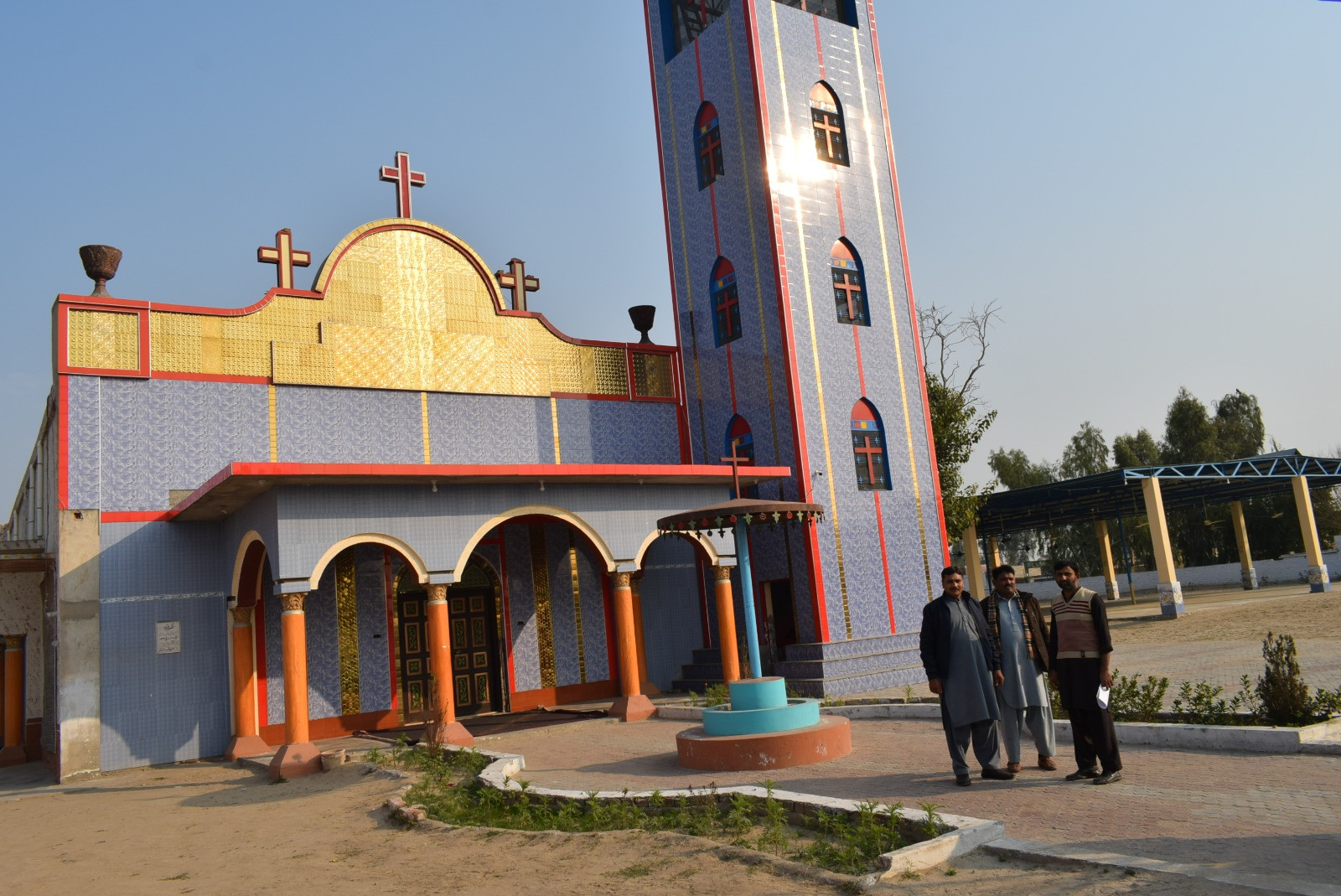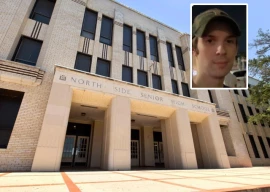
Suhana Abid, a 14-year-old Christian student of class 9, wants to study science subjects but is discouraged by her teacher to do so. Suhana’s elder sister Senaiha faced the same prohibition from the same teacher. Suhana studies at Government Girls High School Chack 102 NB, Sargodha. Talking about her interaction with the same teacher, Senaiha said, “When I was a student in the same school three years ago, Ms Uzma did not allow me to study science either. She taunted me, and would say ‘Will you become Einstein or Newton after studying science subjects?’ She is very biased against Christian students and never misses a chance to degrade them. On their tiniest mistakes or even when there is no mistake - she asks them to stand in the corner of the classroom as punishment.”
Ms Uzma’s discriminatory behaviour persists. She has now filed a complaint about the teacher to the village committee.
In another case, Cedric Sabir with other eight Christian students is studying in class 7 at Government Batala High School, Sahiwal where they are not offered the subject of Ethics. Thus they are instead compelled to study Islamiat. This is in violation of Article 22 of the Constitution of Pakistan. Ashiknaz Khokhar, a Christian human rights activist, took the matter to higher authorities. Resultantly, Chief Executive Officer, District Education Authority, Sahiwal wrote a letter to District Education Officers (DEOs) on April 19 to make arrangements for teaching Ethics to students belonging to minority groups in all educational institutions in Sahiwal. The implementation of this recommendation is yet to be seen.
Education is the fundamental right of every child, and it should be provided without any obstacle, bias or discrimination. Article 25A of the Constitution of Pakistan promises free and compulsory education to all children between five to 16 years. However, the implementation of this article remains a challenge. Because of poverty, a lack of facilities and other social concerns, many children, particularly those from low-income households, are unable to attend school.
Shortage of trained teachers, and gender inequality are also major issues in the field. Girls are particularly disadvantaged in Pakistan, with significantly lower enrolment rates and higher dropout rates than boys. This is due to a variety of causes, including cultural norms, favouring boys’ education over girls’ education, early marriage and childbearing, and a lack of safe and secure schools for females. Proximity to schools and safety are the most prevalent barriers to accessing education for girls. Many rural schools lack essential amenities, such as safe drinking water, electricity and adequate sanitation. The lack of infrastructure and resources in schools makes it difficult for instructors to provide quality education to their students. The structural marginalisation faced by children belonging to religious minority groups further exacerbates the problem.
Christian villages
There are around 50 villages in Punjab where Christians form the largest religious minority group. A larger part of the population - roughly 260,000 - is associated with farming. These villages are known for their diversity that enriches Pakistan’s culture as well as serve as a source of strength for the Christian community in Pakistan.
Post-Independence and until the 1970s, these villages played a pivotal role in maintaining a socio-religious balance as they offered basic infrastructure such as schools, hospitals and dispensaries. Members of the Christian community held respected positions in society, such as politics, civil services, education, the armed forces, the arts, and sports. However, village-based leadership among Christians reduced gradually between 2000 and 2023. One factor behind the decline was that the Christian population shifted to urban areas, while another reason was the weakening of the profile of villages as centres of academic, cultural and social activities.
Key findings
The Centre for Social Justice (CSJ) carried out a study of 56 big and small villages with sizeable populations of Christians entitled ‘How Green Was My Village’.
In terms of quality of education, the study assessed the size of schools and dispersion of teachers across 81 government-run schools, 42 private schools and 35 Church-run schools in these 56 villages. The government schools have the largest infrastructure, followed by Church-run schools and then private schools. The government schools had a total of 6,255 students at an average of 11 students per teacher. In Church-run schools, 8,906 students were enrolled with an average of 37 students per teacher while 17,714 students attended private schools, at the rate of 66 students per teacher.
The number of certified teachers with standard credentials, including PTC, CT, B.Ed., or M.Ed., varied across the schools. Government schools had the highest number of qualified teachers, making it about 4.5 teachers per school, private schools 1.21 and for Church-run schools 1.2 qualified teachers per school.
The data collected by CSJ throws up some interesting results vis-à-vis quality of services and educational outcomes. The study assessed the performance of the schools by the number of students reaching and passing out matriculation in the last three years. For government schools, the trend for students reaching matriculation in the last three years has dropped marginally among both boys and girls. While 768 boys reached matriculation in 2020, the number dropped to 699 in 2022. Similarly, 897 girls reached matriculation in 2020, and the number dropped to 799 in 2022.
The decline was also noticeable among Church-run schools, where 65 boys reached matriculation in 2020 and the number dropped to 47 in 2022. Similarly, 105 girls reached matriculation in 2020 and it dropped to 75 in 2022.
The study reveals that private schools were the only schools where the number of students reaching matriculation in the last three years exhibited an upward trend, even though the average number of students per teacher was the highest among these schools. The number of boys reaching matriculation increased from 33 in 2020 to 47 in 2022 in private schools, and the number of girls reaching matriculation rose from 62 in 2020 to 71 in 2022.
As far as pass out rates for boys is concerned, government schools had the highest pass out rates in students of matriculation, with average matriculation pass out rates being 91 percent, 86 percent and 45 percent in the year 2020, 2021 and 2022 respectively. The pass out rates for Church-run schools were 8 percent, 9 percent, 9.10 percent, and for private schools, 8.93 percent, 13.69 percent and 7.14 percent. Average matriculation pass out rates for girls for government-run schools is 80 percent, 78 percent and 51 percent for the year 2020, 2021 and 2022, respectively. The pass out rates for Church-run schools were 10.20 percent, 10.6 percent and 8.20 percent, and for private schools, 9.02 percent, 10.71 percent and 7.14 percent in respective years.
Another concern raised by the study was the limited availability of schools for girls in some villages. Although the survey results show that more girls are matriculating as compared to boys, some Christian girls discontinued their education after primary or middle or they had to travel long distances to pursue high school education for instance, in Chak 17 Piplan and Chak 270/ TDA. The enumerator Shahid Nazir from Rahim Yar Khan said, “Our village is situated in Khan Pur, Rahim Yar Khan but there is no school for girls' higher education. Girls have to travel at least 30-35 km to attend school. We are also unable to organise their transportation due to meagre financial resources.”
Another criterion of assessment of the schools' quality is the availability of computer literacy and equipment. Unfortunately, the majority of students were not computer literate. Among government schools, only four were equipped with computer /IT facility; only three private and only one Church-run school had IT equipment.
Study analysis
The data show that private schools are severely under-resourced in terms of buildings and teachers despite having the largest number of students. This begs the question that even when teachers are more in number and superior in qualification, the infrastructure is larger, and results are better, why are there fewer students in government schools?
“The government schools keep only students with better credentials in their schools. They don’t work hard with weak students instead they refuse their admissions. So the weak students end up going to Church-run schools or private schools,” Celine Samuel, a retired assistant education officer from Khanewal district, told The Express Tribune. “Secondly, if a family affords to send their children to private school, they prefer it but that does not mean that the students perform better there,” she added.
Jamil Tariq, a Christian teacher from Kot Uddu stressed the biased behaviour of Muslim students and teachers towards Christian students and teachers. has instilled fear and insecurity among Christian students in government schools. In some cases, the discriminatory practices lead to hostility against Christian students. This situation impacts the overall educational achievements of Christian students and pushes them into ghettoisation. For instance, in many schools, it was common to write on the noticeboard “Don’t pray for the non-Muslim deceased” or “Pakistan belongs to Muslims only.” It is not just children who are targetted. Ms Rose Mary, a teacher in a government-run girls’ high school, Chack 35 Stuntz Abad, Mian Channu took early retirement due to discriminatory behaviour of her colleagues.
Nationalisation of Church-run schools
The CSJ study records various reasons for the depreciated education profile in Christian villages.
Some participants of the focus group discussion recalled the golden period of Christian villages when schools for both girls and boys were fully functional, even providing boarding facilities in certain areas. Many girls attended these schools and later were employed in the 1960s and 1970s at a time when women's employment was taboo. The nationalisation of Church-run schools in 1972 was a major setback to the educational achievements of Christians. Large Christian schools that accommodated hundreds of Christian students across Punjab were nationalised and Christian students became aliens in their own schools. The nationalisation led to discrimination against Christian students and employees.
Dr. Yaqoob Khan Bangash, a historian, expressed his views that “While attacking the self-respect and identity of the religious community might not have been the primary aim of nationalisation, this action did severely undermine the Christian’s confidence in Pakistan.” Dr Tahir Kamran, Professor at National Beaconhouse University, states, “Nationalisation caused grave and serious damage to the education system in the country. Ironically, the Church schools subjected to nationalisation were meant for the underprivileged sections of the society. English-medium Church schools were not nationalised probably because they catered to the privileged class.”
According to Peter Jacob, Executive Director of Centre for Social Justice, “The psychological effect of nationalisation surpassed the loss of possession of property, etc. The common Christians suffered deep emotional loss as these prestigious institutions were tied to a sense of pride, history and belonging, and symbolised their journey in faith and gave meaning to their lives in the socio-political context of Pakistan.”
After a de-nationalisation policy was adopted in the 1980s by a Supreme Court ruling, only nine schools had been de-nationalised, out of a total of 26 that were nationalized in 1972 in the villages surveyed. Hence, barely 34 percent of de-nationalisation was implemented. A reason for the low rate of denationalisation is that the government demands money from the Church for returning these schools. Principally, the government should give back these schools without asking for money because these schools rightly belong to the community.
Certain schools were managed by the Punjab Education Foundation (PEF) in Christian villages. However, the surveyors expressed disappointment over the state of these schools.
Charting a future course
Regarding collective and individual right to freedom of religion or belief, right to property, right to development, economic, cultural and social well-being, especially to give effect to the constitutional guarantees under Articles 20, 22, 25, 25A, 27, 36 and 38 there are following recommendations:
Interventions for promoting interreligious harmony, security, peace and celebration of diversity are required. Shakeel Ahmad, Member Advisory Board on Education to Chief Minister speaking to The Express Tribune said, “School Management Councils (SMC) should be empowered more for creating a better environment at schools.”
Reforms are needed at all levels for government schools so that children from minority communities feel comfortable and secure as equal citizens.
Private schools should be monitored regarding their teacher’s number and qualification, infrastructure and environment.
The Punjab Education Department and the Education Ministry are urged to work out a plan and strategy for completing the de-nationalisation of remaining institutions along with a financial grant for full scale rehabilitation of the infrastructure. Returning all nationalised schools to the Church will bring a positive impact in Christian villages. If nationalised schools in urban areas are de-nationalised and supported, the rural students will be able to live in hostels for colleges.
There must be an implementation committee for the said plan involving key stakeholders, including Christian representatives.
Officers dealing with Church schools should be sensitised on minorities’ issues before being assigned the handling of this delicate matter. They must ensure that any procedural delays are duly reported and compensated for.
The government should not demand any money upon returning of the educational institutions to the Church. It should adjust the existing employees in government institutions rather than forcing denationalised institutions to retain them.
Some of the de-nationalised institutions still don’t enjoy institutional autonomy. The government should not bind the Church to continue with the previous policies, which bar them from introducing their own reforms to the de-nationalised institutions.
Nabila Feroz Bhatti is a human rights activist and columnist. She can be reached at nabilaferoz@gmail.com and on X: @NabilaFBhatti
All facts and information are the sole responsibility of the writer












1737618478-0/Express-Tribune---News-Desk-(9)1737618478-0-270x192.webp)











COMMENTS
Comments are moderated and generally will be posted if they are on-topic and not abusive.
For more information, please see our Comments FAQ